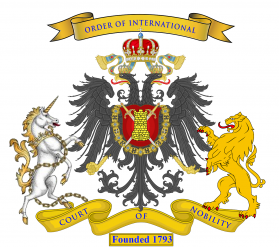RECOGNISED WORLDWIDE BY GOVERNMENTS AND by:
King Charles III - United Kingdom of Great Britain and Northern Ireland,
President Emmanuel Macron - FRANCE,
King Philippe - BELGIUM to name a few.
FOUNDED 1793 - 231 years old.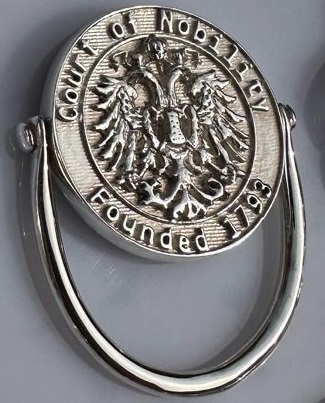
Comes with 'FONS HONORUM' - (The right to grant 'Titles of Nobility')
The fons honorum (from Latin meaning "source of honour") is a concept referring to a person who, by virtue of their official Titled position, has the exclusive right to legitimately bestow 'TITLES OF NOBILITY' on other persons.
Obviously any 'Nobility Titles' you grant come with Legal fees, 'Framed Certificate', correct Regalia and worldwide shipping fees.
As Prince/Princess you may grant the following inheritable registered Titles:
Titles come with automatic complimentary spouse titles.
Duke & Duchess (Legal, Certificate, Regalia and worldwide shipping fees £4,500)
Marquis & Marchioness (Legal, Certificate, Regalia and worldwide shipping fees £4,000)
Count & Countess (Legal, Certificate, Regalia and worldwide shipping fees £3,000)
Baron & Baroness (Legal, Certificate, Regalia and worldwide shipping fees £3,000)
IT CAN EVEN GO IN AMERICAN PASSPORTS
ROYAL HOUSE NAME - Start your Royal Bloodline Dynasty!
A Royal House Name is normally the surname or family name like the Royal House of 'Windsor' is the Royal family of the UK, the Royal family changed their name in 1917 from Saxe-Coburg-Gotha to Windsor due to the 1st World War against Germany.
When purchasing this Prince/Princess Title you will be starting your own 'ROYAL HOUSE'. Your Title would be Prince/Princess (your surname/family name) de Ordo Nobilitatis. If you don't like your surname/family name you can change it to a more suitable name to compliment your new 'Royal House' just like the UK Royal family did in 1917?
VIDEO IN ENGLISH
VIDEO IN FRENCH
This Title is recognised by Royalty & Governments, including Belgium & USA for inclusion onto Passports.
Imagine entering 'High Society' VIP status immediately, eligable to attend all high society events rubbing shoulders with celebrities and royalty. A Prince/Princess Title opens all doors and possibilities. Even Americans can have the Title on their passports now. You are 5 minutes away from the dream becoming reality!
TITLE ADDRESS
Prince/Princess (your name) de ON (Ordo Nobilitatis)
All your children are Princes and Princesses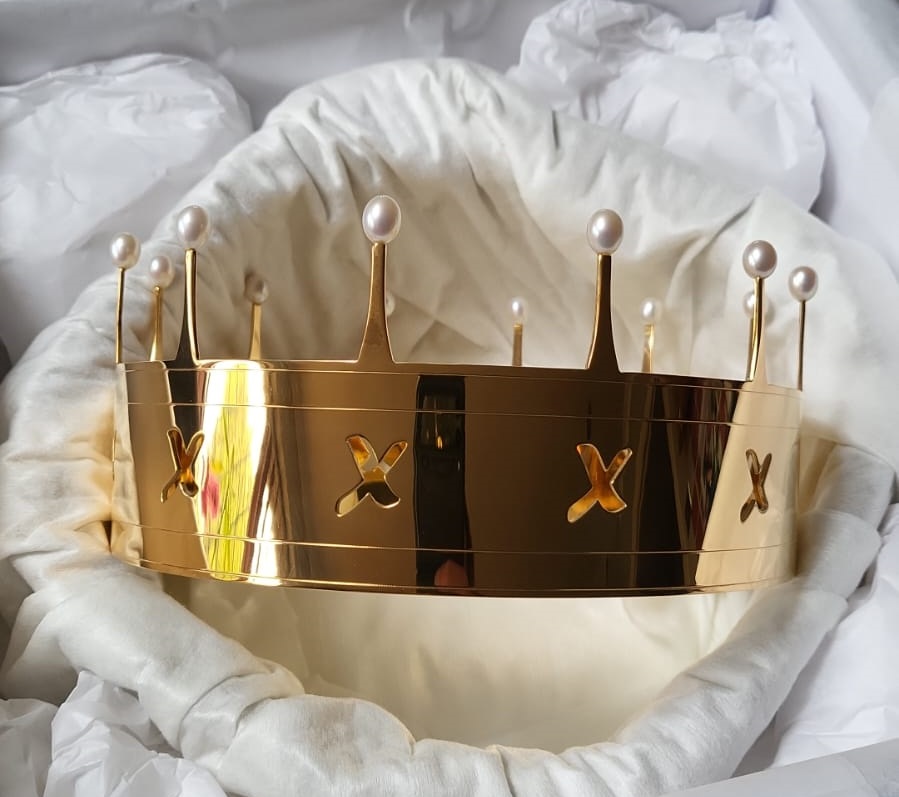
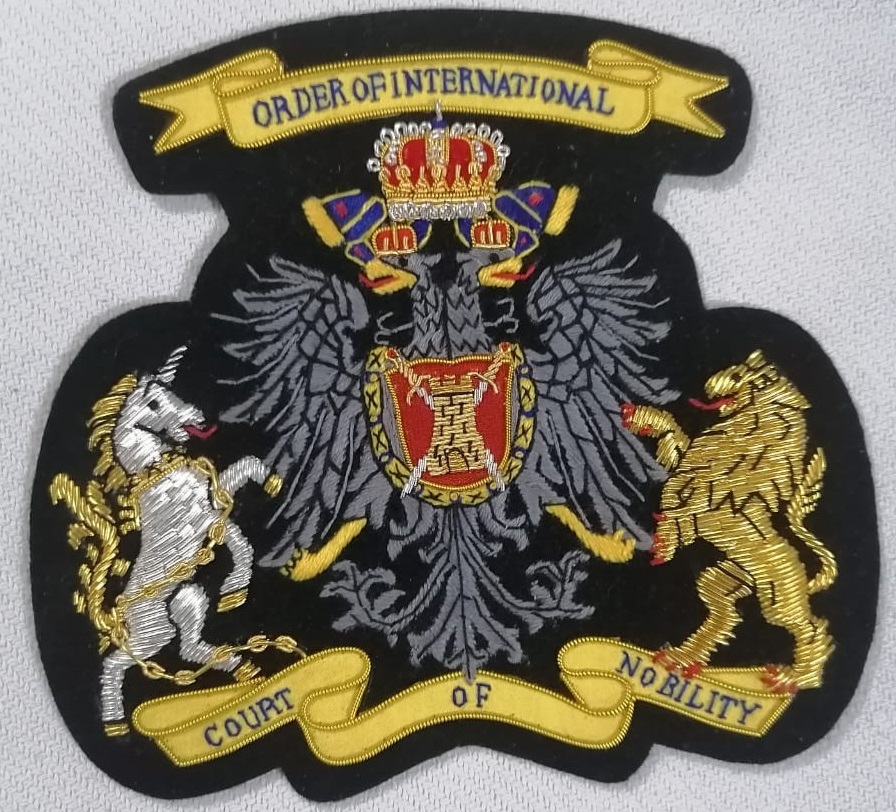
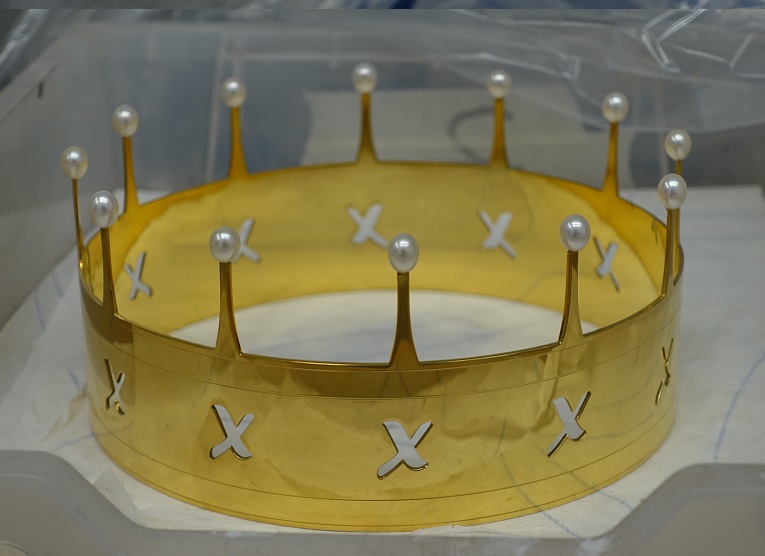
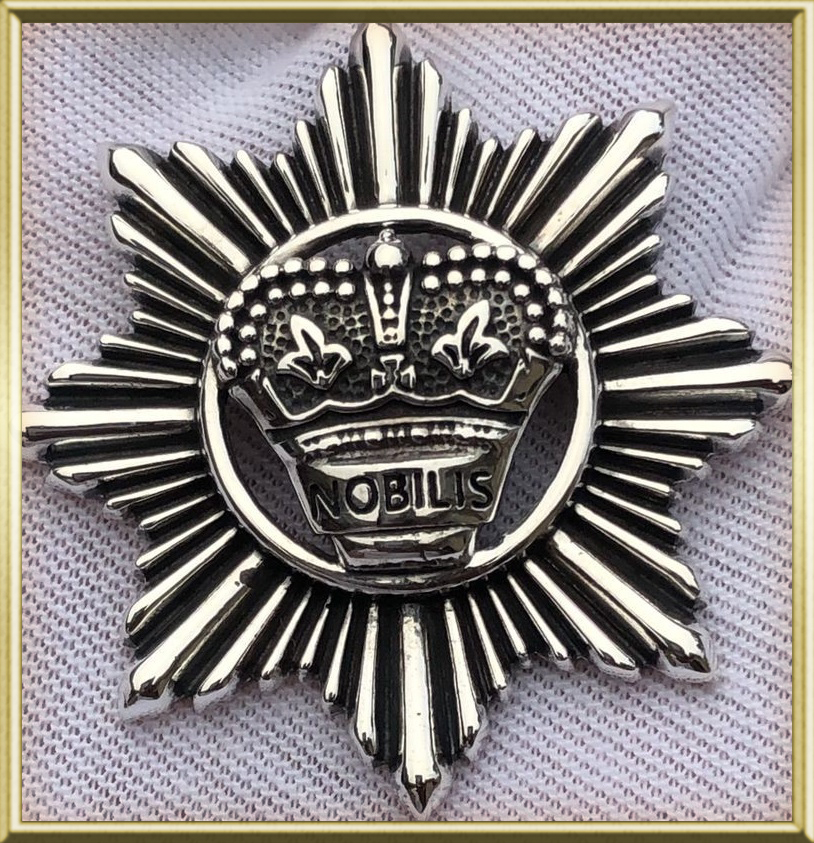
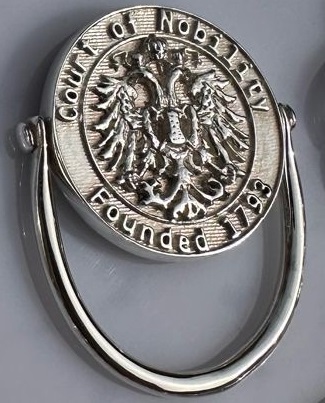
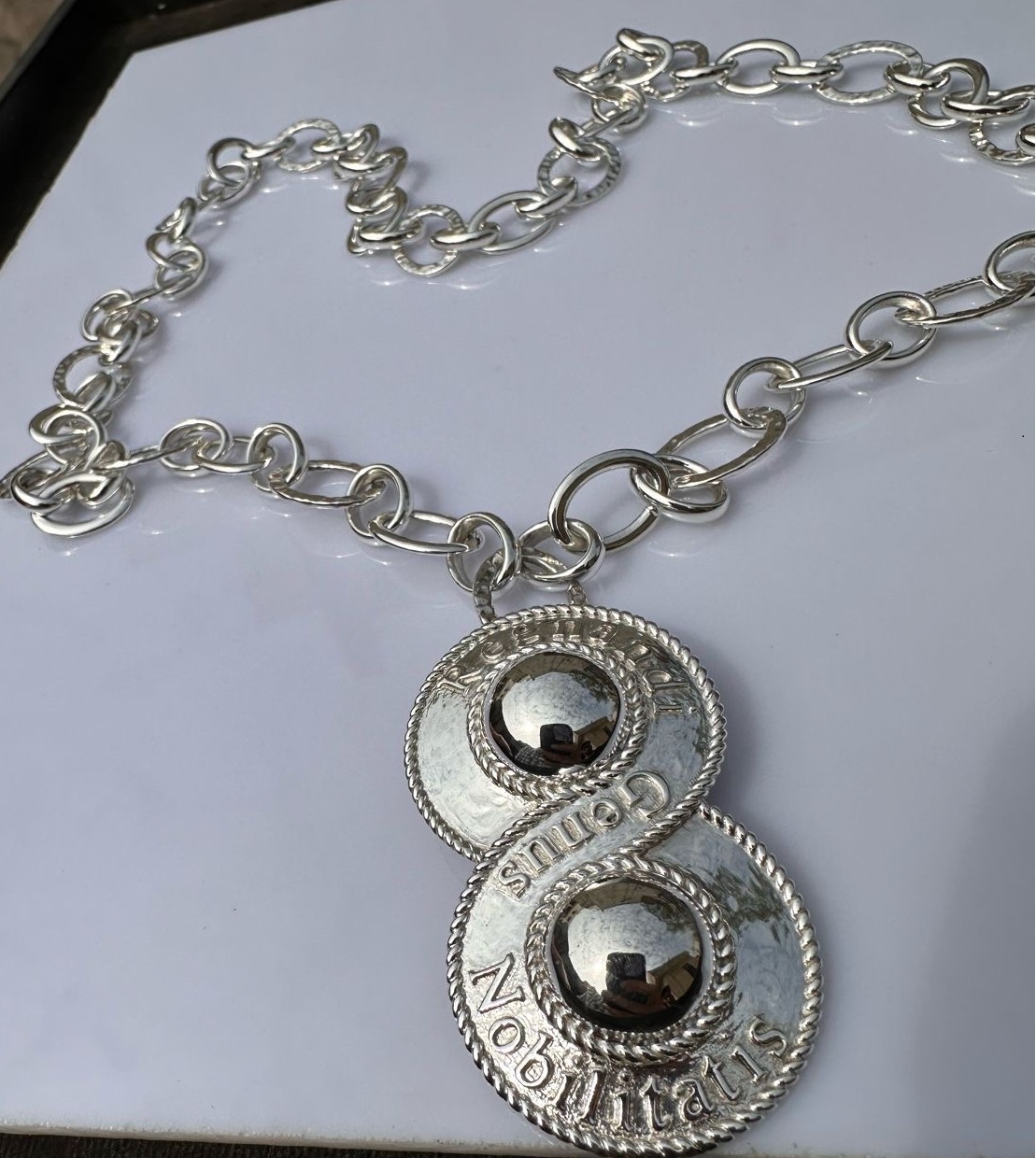
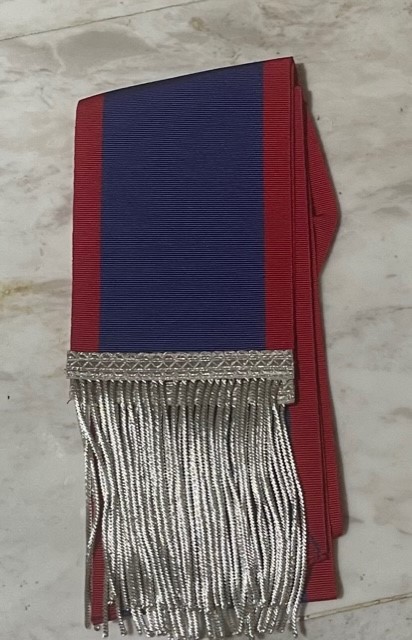
Royal ring.
Comes with:
Gold & Silver Crown
Royal Ring (Engraved on the flip side)
Chain
Cloak with embroidery Crest
Royal Blue sash with silver tassels
Nobility Society's Star badge pictured above.
Embroidery crests.
Star Badge & Medals
INCLUDES SOLID SILVER & GOLD CROWN
WITH REAL PEARLS.
INHERITABLE (HRH) Prince and Princess (All Children are Princes and Princesses)
- (MEMBERSHIP IS INCLUDED WITH THE TITLE)
ARE YOU A DESCENDANT OF NOBILITY OR ROYALTY?
YOU WOULD QUALIFY TO BE AWARDED THIS TITLE!
SEE ALL 10 REASONS TO QUALIFY BELOW:
Titles awarded for:
1. Noble Ancestry 'Descendant of Nobility, Royalty or Feudal Title'
2. Heroism or Honourable Deeds
3. Charity work or donations to charity - (Receipt of your Donation to registered Charity to be guaranteed accepted)
NEW : (We can arrange your acceptance through a charity donation in the UK that the 'Court of Nobility' approves & supports)
4. Local Community support, Politics, Government and Civil Servants
5. Industry, Entrepreneurs, Sport or Coaching (Website to be accepted)
6. Humanitarian, Volunteer work or Military Service
THIS TITLE IS GRANTED BY THE
"ORDER OF INTERNATIONAL COURT OF NOBILITY" (Originally founded 1793)
Only 5 Prince/Princess Titles are awarded each year "You could be one of them"?
TITLE ADDRESS
Prince/Princess (your name) de Ordo Nobilitatis
All your children are Princes and Princesses
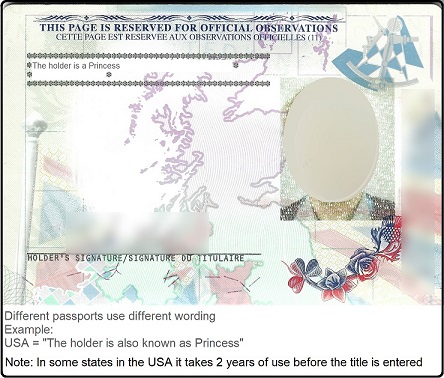
FIND OUT NOW IF YOU QUALIFY- CHAT OR TEXT NOW ON - WhatsApp Click & Chat
PETITION NOW:
To be granted the Title a person must qualify for one of the above.
(send an email to nobletitles@outlook.com with details of which one you qualify for, to be granted the Title Prince and Princess)
PETITION DETAILS AT THE BOTTOM
HISTORY
Nobility has always had secret organizations that they belonged to, ever since the French revolution 1789, where the commoners sought to abolish nobility with fatal consequence's. They would meet in secret once a year bringing with them a bronze or silver plate which they put on the table and used to eat food off. A piece of bread was placed on the plate (to cover the crest, in case any uninvited persons came in) which all food was then served onto the bread, at the end of the meal the bread could be eaten or given to the poor.
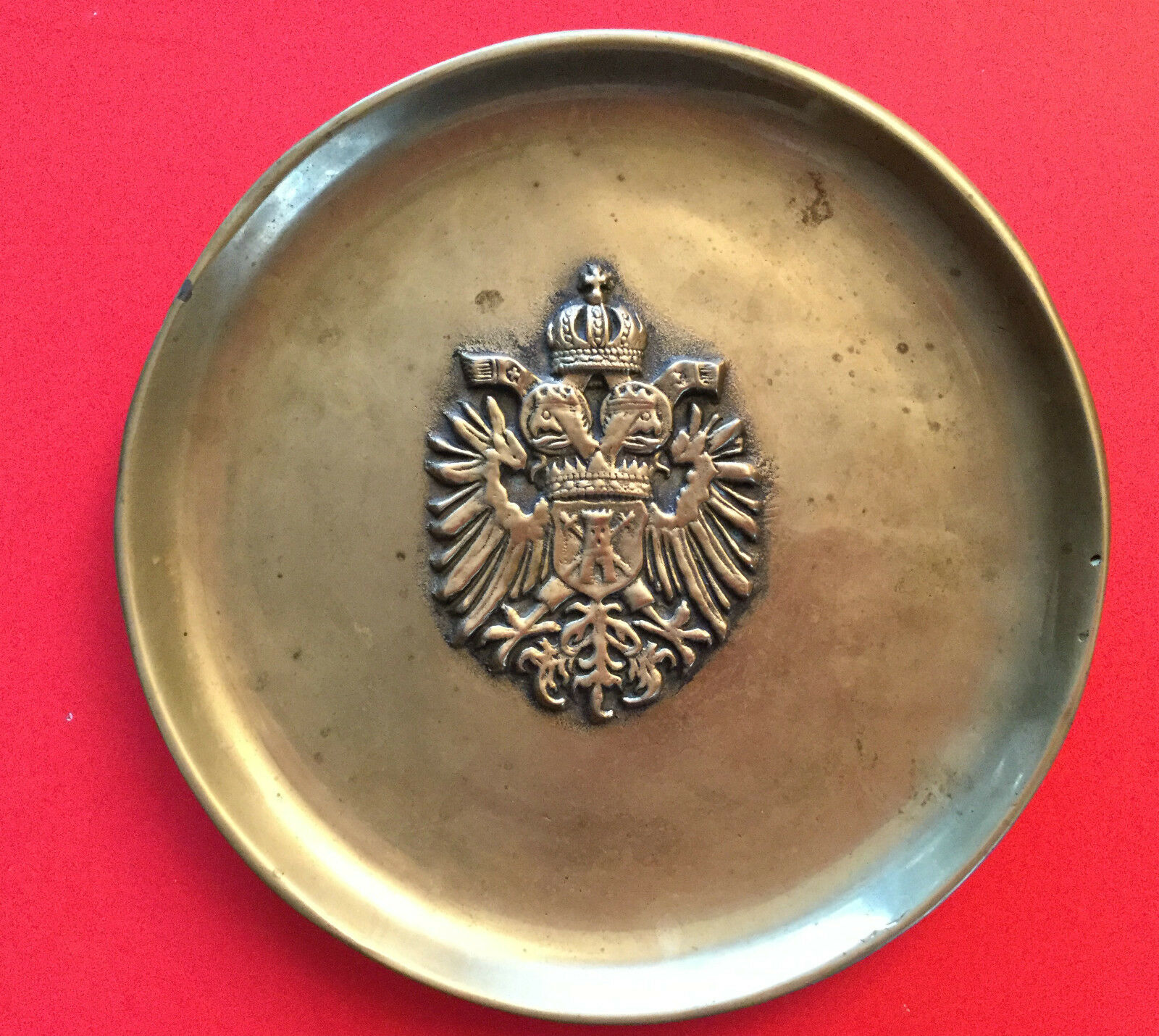
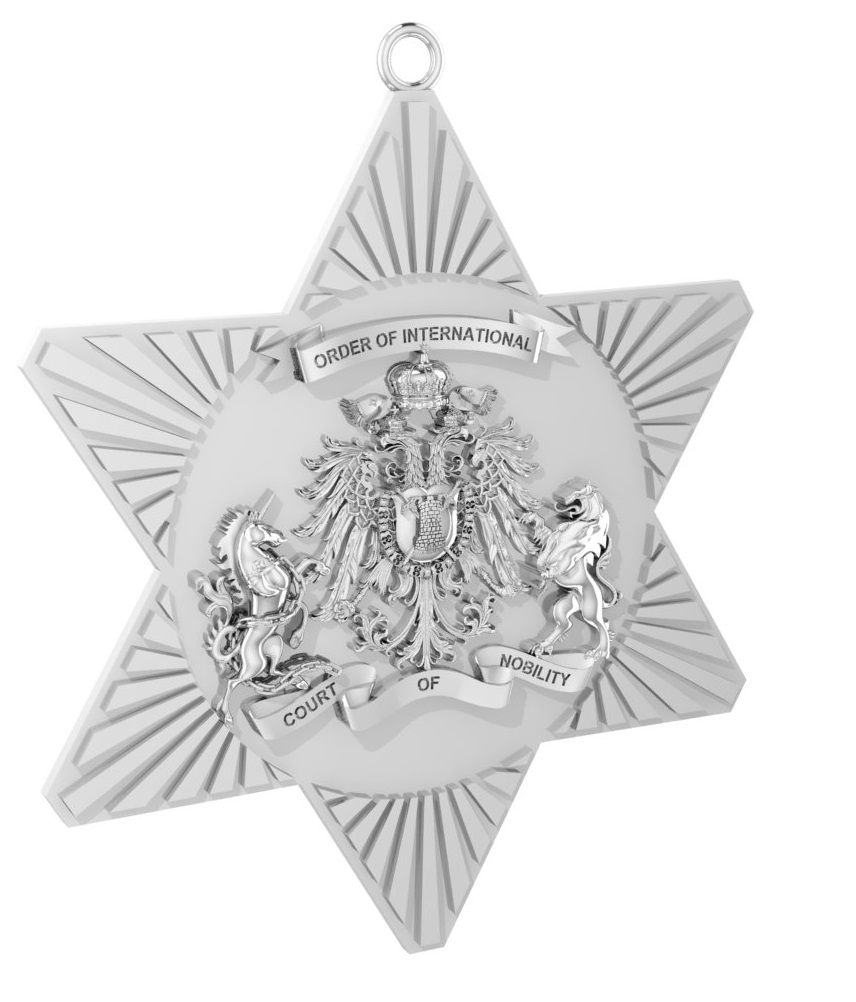
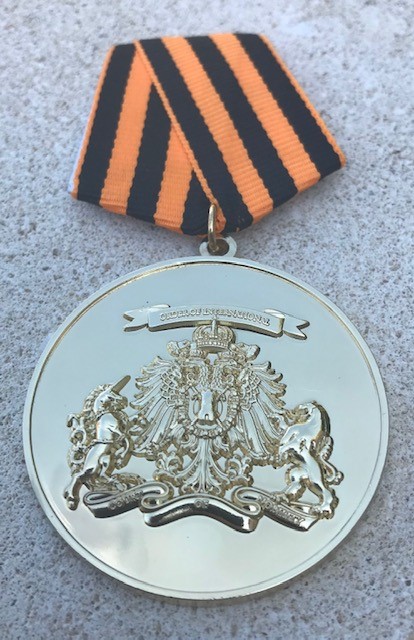
The above plate is Circa 1800s Star Badge Medal
The plate symbolised that ‘Nobility Class’ would always be high society and eat well. It was a “membership Plate” (an old fashion membership card). Many secret high society Nobility associations, orders, and clubs were formed after 1806 with the dissolution of the HOLY ROMAN EMPIRE by Emperor, Francis II of the House of Habsburg-Lorraine, he abdicated his title and released all imperial states and officials from their oaths and obligations to the empire.
We now live in a worldwide enlightened age where organisations and societies open their doors through the medium of the internet. It is no longer necessary to be secret yet security is most important.
Heraldic Meaning of The Order of International Court of Nobility Coat of Arms 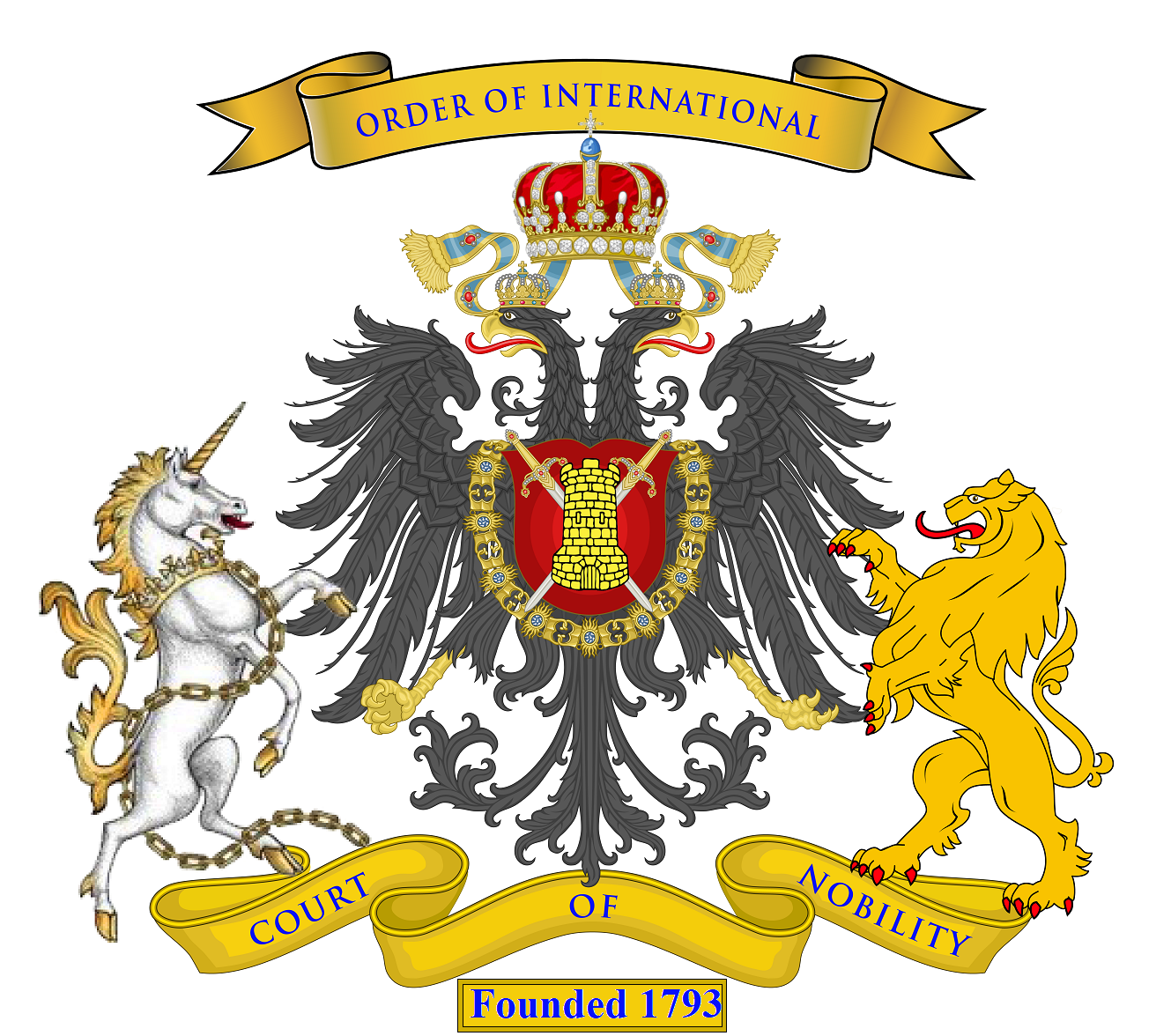
Double headed Eagle = Represents Holy Roman Empire
Lion and Unicorn = Represents Strength of Christ
Crowns = Represents the International Rulers
Castle = The castle signifies spiritual power and vigilance on the watch as well as home and safety. The tower is very similar to this and is an emblem of grandeur and society.
Swords = 2 crossed swords pointing down means the fight is over. The purpose of preservation of Nobility Class is over by existence of this Order.
Official Court Wax Seal = Does not have the Lion and Unicorn which demonstrates multi religious officialdom of authority.
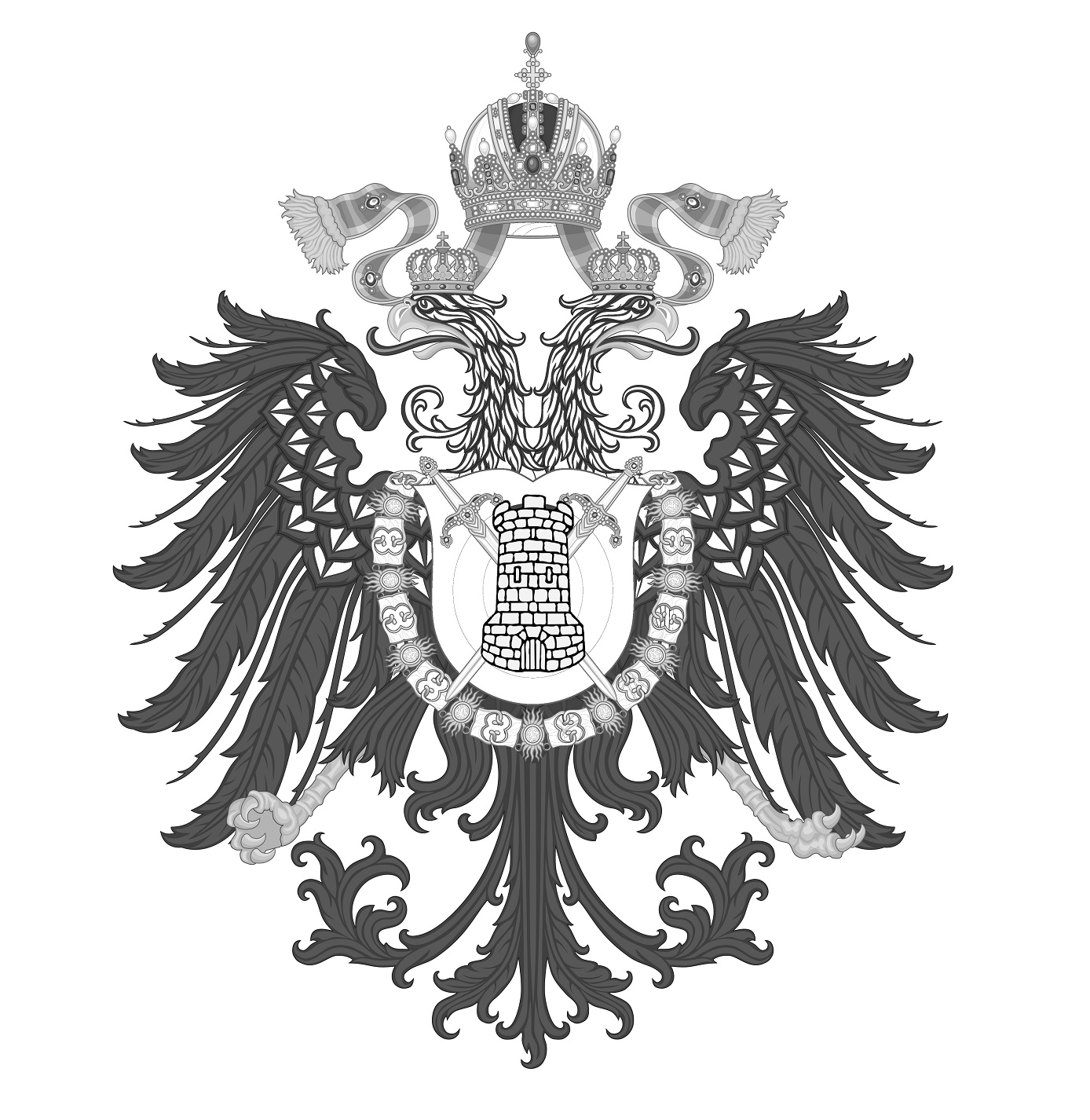
Background to the Order (originally founded 1793)

"LOUIS JOSEPH de BOURBON, PRINCE OF CONDE" Letter Appointment to the post of general control clerk of Madame's House Signed on April 29, 1758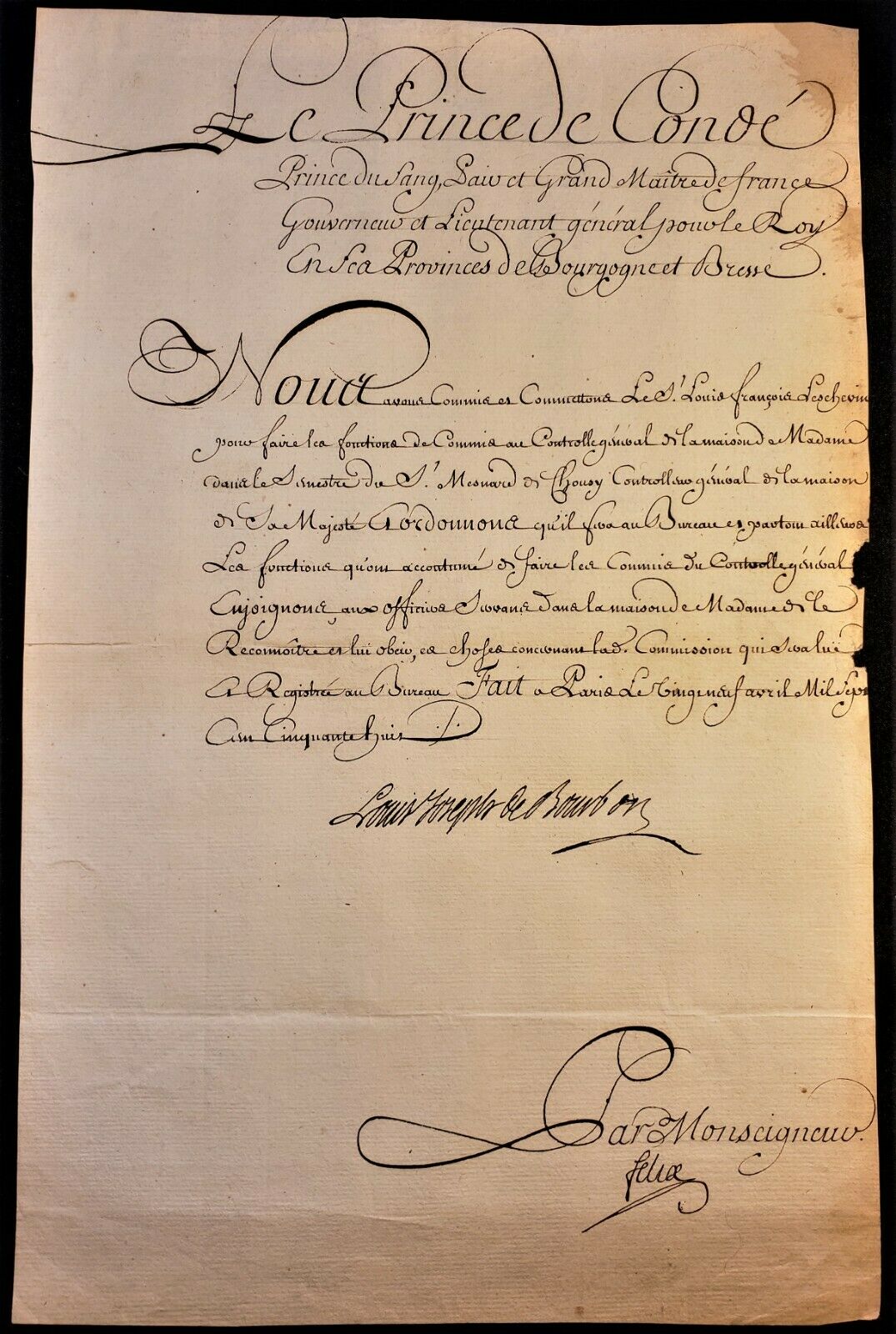
From the 'Order of International Court of Nobility' collection of historical documents.
Born on 9 August 1736 at Chantilly, Louis Joseph was the only son of Louis Henri I, Prince of Conde (1692–1740) and Landgravine Caroline Caroline of Hesse-Rotenburg (1714–41). As a cadet of the reigning House of Bourbon, he was a prince du sang.
His father Louis Henri, was the eldest son of Louis de Bourbon, Prince of Conde (known as Monsieur le Duc) and his wife Louise Francoise de Bourbon, legitimated daughter of Louis XIV and Madame de Montespan.
During his father's lifetime, the infant Louis Joseph was known as the Duke of Enghien, (duc d'Enghien). At the age of four, following his father's death in 1740, and his mother's death in 1741, he was placed under the care of his paternal uncle, Louis Count of Clermont, his father's youngest brother. During both the reigns of King Louis XV and his grandson, Louis XVI, Louis Joseph held the position of Grand Maître de France in the King's royal household, the Maison du Roi.
Obtaining the rank of general, he fought in the Seven Years’ War with some distinction, serving alongside his father-in-law, the Prince of Soubise. He was also Governor of Burgundy.
Furthermore, the Prince was the leader of the Condé army of emigres. He used her great fortune to help finance the exiled French community's resistance movement.
Louis Joseph lived with his mistress Maria in France until the French revolution, when the couple left for Germany and then Great Britain. In 1795, Prince Honoré of Monaco died, and on 24 October 1798, the Prince of Condé and Maria were married in London. The marriage was kept secret for a decade, the couple reportedly becoming openly known as husband and wife only after 26 December 1808.
During the French Revolution, Louis Joseph was a dedicated supporter of the monarchy and one of the principal leaders of the counter-revolutionary movement. After the storming of the Bastille in 1789, he fled France with his son and grandson, before the Reign of Terror which arrested, tried and guillotined most of the Bourbons still living in France: Louis XVI, Marie Antoinette and the Duke of Orleans (Philippe Egalite) were executed in 1793, and the king's sister, Madame Elisabeth, was beheaded in 1794.
Louis Joseph established himself at Coblenz in 1791, where he helped to organize a new "Court of Nobility" and lead a large counter-revolutionary army of emigres. In addition to containing the prince's grandson, Louis-Antoine-Henri de Bourbon-Conde, duc d’Enghien, and the two sons of his cousin, the late king's brother, the compte d’Artois, the corps included many young aristocrats who eventually became leaders during the Bourbon Restoration years later. This group also included Armand-Emmanuel du Plessis, Duc de Richelieu, Pierre Louis Jean Casimir de Blacas, and Francois-Rene de Chateaubriand.
The Army of Conde initially fought in conjunction with the Austrians. Later, due to differences with the Austrian plan of attack, however, the Prince de Condé entered with his corps into English allies in 1795. In 1796, the army fought in Swabia.
In 1797, Austria signed the Treaty of Campo Formio with the First French Republic, formally ending its hostilities against the French. With the loss of its closest allies, the army transferred into the service of the Russian tsar, Paul I and was stationed in Poland, returning in 1799 to the Rhine under Alexander Suvorov. In 1800 when Russia left the Allied coalition, the army re-entered English service and fought in Bavaria.
The army was disbanded in 1801 without having achieved its principal ambition, restoring Bourbon rule in France. After the dissolution of the corps, the prince spent his exile in England, where he lived with his second wife, Maria Caterina Brignole, the divorced wife of Honore III, Prince of Monaco, whom he had married in 1798. She died in 1813.
With the defeat of Napoleon, \Louis Joseph returned to Paris, where he resumed his courtly duties as grand \maître in the royal household of Louis XVIII. He died in 1818 and was succeeded by his son, Louis Henri. His daughter, Louise Adelaide de Bourbon, who was a nun and had become the abbess of Remiremont Abbey, survived until 1824. He was buried at the Basilica of St Denis.
300,000 nobles were killed in the French revolution. The ones that escaped lost their property. The émigrés were those who fled the revolution, either for security, safety or to organise counter-revolution. There were more than 100,000 émigrés between 1789 and 1794.
Only a small proportion of émigrés were nobles, in fact, most belonged to the Third Estate. They went into exile in France’s outer provinces, other European kingdoms or across the channel in London.
London had the largest émigré population, housing around 40,000 refugees from revolutionary France. The émigrés there attempted to recreate the society and culture of the Ancient Régime.
Other émigrés, particularly those in Coblenz, attempted to organise counter-revolutionary armies. These armies were beset with problems, however, and their early military ventures ranged from ineffective to disastrous.
The new regime implemented harsh penalties against the émigrés, ordering the seizure and sale of their properties, banning them from re-entering France and promising the death penalty if they returned.
Under the leadership of King Louis XVI’s oldest brother, the comte de Provence (future king Louis XVIII), many émigrés set up a “Court of Nobility” at Koblenz in the Rhineland of Germany. One of their number, Louis-Joseph, prince de Condé, commanded an army of émigrés that assisted foreign powers in the wars against France, but the exiles never posed a serious military threat. A defeat at Quiberon Bay in southern Brittany in July 1795, in an attempt to aid a peasant revolt, resulted in the execution of over 600 émigrés.
I wasn’t until 1802 when Napoleon Bonaparte gave amnesty to all émigrés.Many Nobles continued to be part of the “Court of Nobility” and later (circa early 1800s) formed a secret Order in London where a lot of French nobles then resided, this came about because of expulsion of religious orders by Third Republic France, therefore the nobles started an Order out of spite for Third republic France.
The Legion of Honour (French: Légion d'honneur) is the highest French order of merit, both military and civil. Established in around the same period 1802 by Napoleon Bonaparte, the First Consul, to create a reward to commend civilians and soldiers. From this wish was instituted a Légion d'honneur,[2] a body of men that was not an order of chivalry, for Napoleon believed that France wanted a recognition of merit rather than a new system of nobility. However, the Légion d'honneur did use the organization of the old French orders of chivalry, for example, the Ordre de Saint-Louis. The insignia of the Légion d'honneur bear a resemblance to those of the Ordre de Saint-Louis, which also used a red ribbon.
Name changes through history
The Order has had many names “Court of Nobility”, “Order of Nobility” and now “The Order of International Court of Nobility” developed from the original Court of Nobility in Koblenz in Germany. It has one fundamental ideal that is “preservation of Nobility as a Class”.
Terms and conditions of Awarded Titles
- Petitioners and recipients accept and understand that Titles granted through “Letters Patent” of the Order are subject to the judgement and opinion of the ‘adjudication council members’ with their decision being accepted as final.
- Only one petition can be made per year per title.
- Recipients of awarded titles have 30 days to claim their title.
- Only members may be awarded Titles. (Membership will be granted if accepted)
- Regalia for titles are the responsibility of the petitioner or recipient.
- Titles can only be issued with Regalia (Titles are not available without regalia)
Prince and Princess Regalia
Cloak with Embroidery coat of arms (2)
Blue sash with tassels (2)
Medal (2)
Silver Breast Star (2)
Lapel/Tie Badge (2)
Large Frame 'Grant Letters Patent Certificate' with Embroidery: Coat of Arms, Fleur De Lys and Crown decorations.
Large Certificate
Collar Prince and Princess Chain (2)
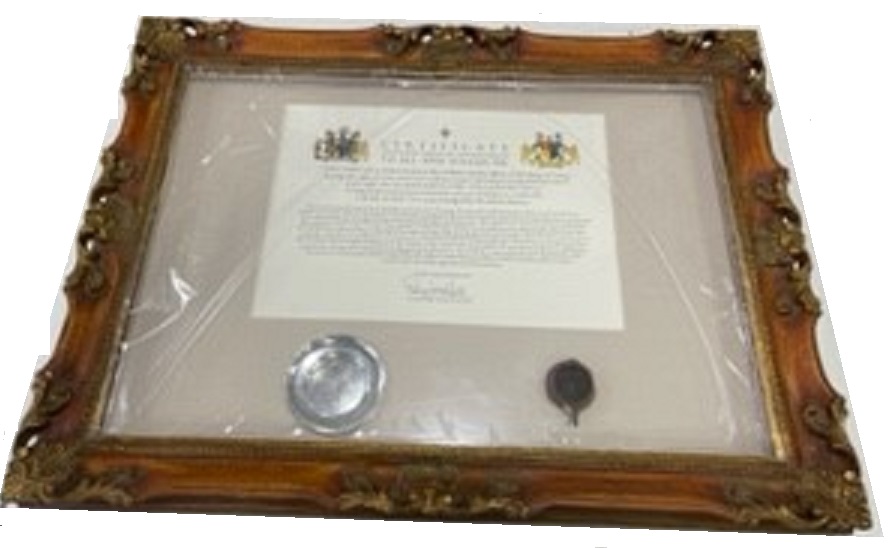
- Whilst there is no charge for awarded Titles it is expected that recipients remain members of the Order. If the recipient is only a member to receive the title, or a member for less than 5 years the said title will be deemed void and extinct. The whole concept and modus operandi of the Order is the preservation of Nobility class through membership.
In submitting a petition you accept the above Terms and conditions.
For further information please email us with the following information:
Name
Address
Phone
Age
Occupation
PETITION REASON (Act)
PETITION HERE for Title of Princes and Princess Title.

